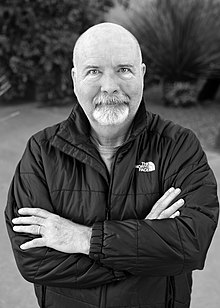Technology career
Hillis has founded a number of technology companies, including Thinking Machines Corporation, Applied Minds, Metaweb Technologies, Applied Proteomics, and Applied Invention. Hillis has over 300 issued patents in fields including parallel computers, touch interfaces, disk arrays, forgery prevention methods, electronic and mechanical devices, and bio-medical techniques, RAID disk arrays, multicore multiprocessors and for wormhole routing in parallel processing.
Thinking Machines
As a graduate student at MIT, Hillis co-founded Thinking Machines Corporation to produce and market parallel computers, developing a series of influential products called the Connection Machine. At the time the company produced many of the fastest computers in the world. The Connection Machine was used in demanding computation and data-intensive applications. It was used by the Stanford Exploration Project for oil exploration and for pioneering data mining applications by American Express, as well as many scientific applications at organizations including Schlumberger, Harvard University, University of Tokyo, the Los Alamos National Laboratory, NASA, Sandia National Laboratories, National Center for Supercomputer Applications, Army High Performance Computing Research Center, University of California Berkeley, University of Wisconsin at Madison, and Syracuse University.
In addition to designing the company's major products, Hillis worked closely with users of his machine, applying it to problems in astrophysics, aircraft design, financial analysis, genetics, computer graphics, medical imaging, image understanding, neurobiology, materials science, cryptography, and subatomic physics.
At Thinking Machines, he built a team of scientists, designers, and engineers, including people in the field as well as those who later became leaders and innovators in multiple industries. The team included Sydney Brenner, Richard Feynman, Brewster Kahle, and Eric Lander.
Among the users of Thinking Machines computers was Sergey Brin, who went on later to found Google, and Neal Stephenson, who attempted to use a CM-2 to implement a game that he later turned into the novel Snow Crash.
Disney Imagineering
In 1996, Hillis joined The Walt Disney Company in the newly created role of Disney Fellow and as vice president, Research and Development at Disney Imagineering. He developed new technologies and business strategies for Disney's theme parks, television, motion pictures, and consumer products businesses. He also designed new theme park rides, a full-sized walking dinosaur, and various micro mechanical devices.
Applied Minds
In 2000, Hillis co-founded the R&D think-tank Applied Minds with his Disney colleague Bran Ferren. Minds is a team of engineers, scientists, and designers that provide design and technology services for clients. The creative environment and the diverse projects it undertook gained Applied Minds abundant media attention. "It's as if Willy Wonka's chocolate factory just yawned wide to welcome us. Only here, all the candy plugs in," said an article in Wired magazine. Work done at the firm covered the range of industries and application domains, including satellites, helicopters, and educational facilities.
While at Applied Minds, Hillis designed and built a large-scale computer data center for Sun Microsystems (the Sun Modular Datacenter) that would fit into a standard 20-foot shipping container, solving, among others, the problems of accommodating processor capacity, cooling, power requirements, and storage within a uniquely portable solution. This type of "datacenter in a box," has now become a common method for building large data centers.
For Herman Miller, Hillis designed an audio privacy solution based on phonetic jumbling—Babble —which was received in the media as a version of the Cone of Silence, and was marketed through a new company, Sonare. Also for Herman Miller, Hillis developed a flexible reconfigurable power and lighting system, which was marketed through another new company, Convia.
As part of an early touchscreen map table interface, Hillis invented and patented the use of multiple touch points to control a zoom interface, which is now called "pinch to zoom.". One of these patents was the basis for the USPTO decision to reject Apple Inc.'s claim on a "pinch-to-zoom" patent in its legal dispute with Samsung, on the grounds that it was described in the Hillis patent.
Metaweb Technologies
In 2005, Hillis and others from Applied Minds founded Metaweb Technologies to develop a semantic data storage infrastructure for the Internet, and Freebase, an open, structured database of the world's knowledge. That company was acquired by Google, and its technology became the basis of the Google Knowledge Graph.
Cancer research and Applied Proteomics
In 2012, Hillis helped to create a research program on cancer and proteomics as Professor of Research Medicine at the Keck School of Medicine of USC, and the principal investigator of the National Cancer Institute's Physical Sciences in Oncology Laboratory at USC. He co-founded Applied Proteomics (API) with David Agus to make proteomics-based biomarker discovery practical. Hillis and his colleagues at API developed one of the first protein biomarker discovery platforms and a blood test for early stage colon cancer, but they were unable to convince investors to finance taking their proteomic technology to the market.
Hillis has academic appointments as the Judge Widney Professor of Engineering and Medicine at the University of Southern California, Professor of Research Medicine at the Keck School of Medicine of USC, and research professor of engineering at the USC Viterbi School of Engineering. He was the first principal investigator of the National Cancer Institute's Physical Sciences in Oncology Laboratory at USC.
Applied Invention
In 2015, Hillis co-founded Applied Invention, an interdisciplinary group of engineers, scientists, and artists. Applied Invention develops technology solutions in partnership with other companies and entrepreneurs.
Applied Invention co-founded Dark Sky, a weather forecasting technology company with consumer web and mobile applications that was eventually sold to Apple.
